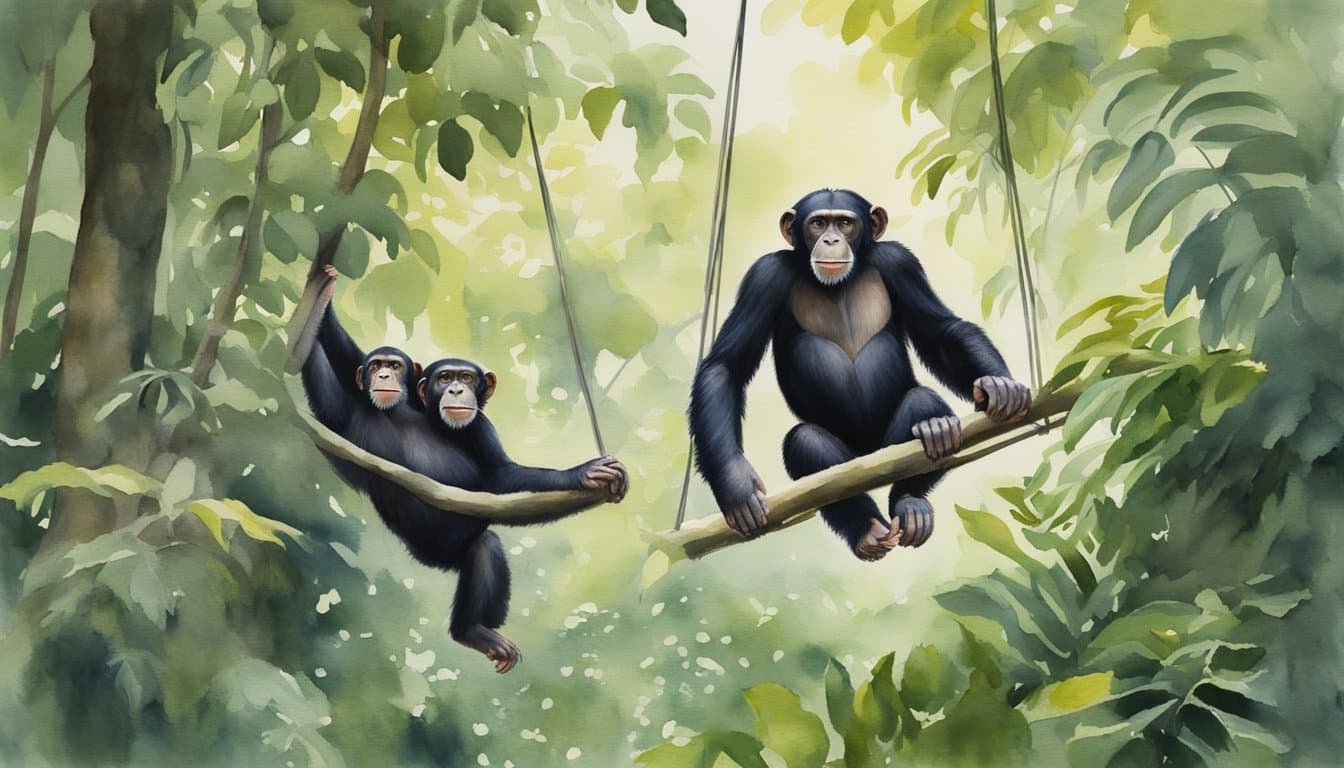Understanding Chimpanzee Behavior
Chimpanzee behavior is a complex tapestry that emerges from their social structures, communicative skills, and cognitive abilities. These primates exhibit a range of behaviors that underscore their sophisticated social systems and intelligence.
Social Structures and Hierarchies
Chimpanzees live in communities where social dynamics are paramount. Females tend to migrate between communities, while males typically remain in their natal groups, where they vie for dominance. Ranking in male chimpanzees is determined by strength, intelligence, and alliances. High-ranking males often have better access to resources and mating opportunities. The social ladder is maintained and negotiated through displays of aggression, but also through subtler means of competition and grooming.
Communication and Tool Use
Chimpanzee communication comprises a rich mix of vocalizations and gestures, many of which serve to maintain the complex fabric of chimpanzee society. Alarm calls, for example, are crucial for warning others of danger. Tool use among chimpanzees is a testament to their intelligence. They fashion tools from twigs or leaves to extract insects from their nests or to sip water from tree hollows. Such use of tools reveals that chimpanzees not only understand their environment but can also manipulate it to their advantage.
Intelligence and Problem Solving
The cognitive abilities of chimpanzees are formidable. They can solve problems, as evidenced by their use of tools, and can remember solutions for future use. Researchers have observed chimpanzees making strategic decisions, whether in forging alliances or planning a hunt. While they may not grasp the beliefs of others, they can ascertain what another chimpanzee knows, which is crucial during hunts or when navigating complex social interactions.
Chimpanzees and Human Interaction

Interactions between humans and chimpanzees can be complex and often pose risks for both parties, especially when the natural distance between species is disregarded, such as when chimpanzees are kept as pets or when humans encroach on their natural habitats.
Chimpanzees as Pets and in Captivity
While chimpanzees might appear as cuddly and docile creatures, especially as infants, they grow into strong and often unpredictable adults. Cases of pet chimpanzees turning on their owners, sometimes resulting in severe injuries, demonstrate the inherent dangers of keeping these wild animals in domestic settings. Moreover, diseases can be transmitted between humans and chimpanzees, with potentially serious consequences.
Conservation Efforts and Habitat Protection
Habitat loss and human interference have critically endangered chimpanzee populations in the wild. Primatologist Jane Goodall’s work has shed light on the need for wildlife conservation efforts to protect these intelligent beings and their ecosystems. Initiatives to create protected areas and minimize human-chimpanzee conflict are key for their coexistence and the preservation of biodiversity.
Notable Research and Studies on Chimpanzees
Pioneering research, such as that by Jane Goodall, has illuminated chimpanzee societies and their interactions with humans. Studies revealing that wild chimpanzees inform ignorant group members of danger show their complex communication abilities. Understanding these practices is crucial for managing safe interactions with humans and informing conservation strategies.
Risks and Safety Around Chimpanzees

In the wild and captivity, chimpanzees can display aggression, and understanding their behavior is vital for safety and prevention of conflicts.
Understanding Aggressive Behaviors and Triggers
Chimpanzees exhibit a complex range of behaviors and can become aggressive for various reasons. Male chimpanzees may show violence to establish or maintain dominance over their territory or access to mates. Such aggression can include explicit displays or actual physical attacks that may result in serious injuries or, infrequently, killing. Chimpanzees in the western region of Uganda and other parts of East and West Africa are especially noted for these behaviors that appear to have evolutionary roots, aimed at survival and reproductive success. National Geographic provides detailed insights into these aspects of chimpanzee behavior.
Preventing and Managing Conflicts with Chimpanzees
To prevent and handle conflicts with chimpanzees, one must minimize interactions that could trigger their aggression. This includes securing food sources to avoid attracting them, maintaining a safe distance, especially from male chimps, and staying clear of their territory. Researchers in Tanzania have studied the population dynamics of chimpanzees to better understand how to coexist peacefully. When visiting areas where chimpanzees live, it’s essential to follow guidelines and the advice of experts to mitigate risks.
Chimpanzees in the Wild vs Captivity
Chimpanzees in captivity show different patterns of aggression compared to their wild counterparts. In the wild, their predatory behavior is part of natural survival, whereas captive chimpanzees might become aggressive due to stress, confinement, or human error. The sheer size and strength of a chimpanzee, which can reach upwards of four feet when standing, necessitate stringent safety measures in sanctuaries and zoos. Studies like those on demographies in Gombe National Park, Tanzania, often provide key learnings for managing captive populations and ensuring their well-being.

